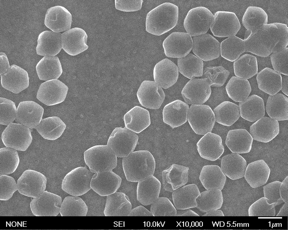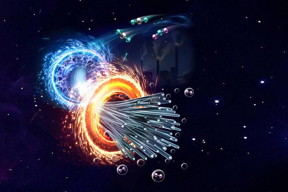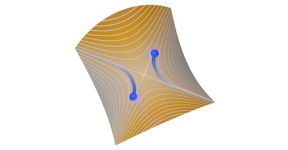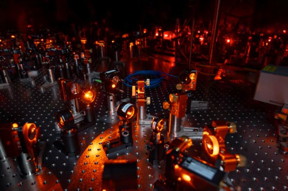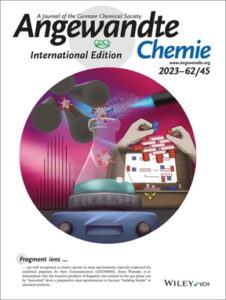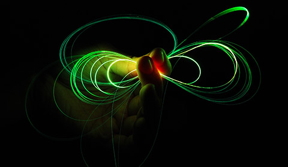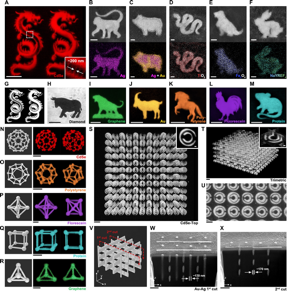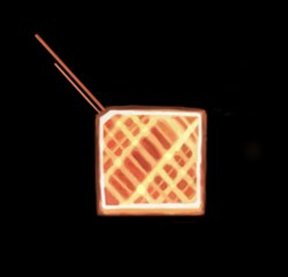Kezdőlap > nyomja meg > Channeling mechanical energy in a preferred direction
Absztrakt:
A research group led by scientists from the RIKEN Center for Emergent Matter Science have developed a unique material, based on nanofillers embedded in a hydrogel, that can channel mechanical energy in one direction but not the other, acting in a “nonreciprocal” way. With this composite material–which can be constructed at various sizes–the team was able to use vibrational up-and-down movements to make liquid droplets rise within a material against gravity. Using this material could thus make it possible to make use of random vibrations and move matter in a preferred direction.
A mechanikai energia kívánt irányba történő csatornázása
Saitama, Japan | Posted on April 14th, 2023
Channeling energy in a preferred direction is an important property that actually makes life possible. Many basic biological functions such as photosynthesis and cellular respiration are made possible by channeling random fluctuations in nature in a nonreciprocal way, to drive a system away from increasing entropy, like the famed Maxwell’s demon. For example, devices that allow energy to move preferentially are in electronics, where they allow AC current to be transformed into DC current. Similar devices are used in the fields of photonics, magnetism, and sound. However, despite the many potential uses, creating devices that channel mechanical energy has proven to be more difficult.
Now, a RIKEN-led group has developed a remarkable but uniform material that is relatively easy to produce and can perform this function. To create it, the group used a hydrogel–a soft material made mainly of water and a polyacrylamide network–and embedded graphene oxide nanofillers into it at a tilted angle. The hydrogel is fixed to the floor, so that the top part can move when subjected to a shear force but not the bottom. And the fillers are set at a tilted angle, so that they angle clockwise from top to bottom. When a shear force is applied from right to left into the leaning nanofillers, they tend to buckle and hence lose their resistance. But if the force is from the other direction, and the nanofillers are facing away from it, the applied shear merely makes them stretch even longer, and they maintain their strength. This allows the sheet to deform in one direction but not the other, and in fact the group measured this difference, finding that the material was approximately 60 times as resistant in one direction than the other.
As an experiment to demonstrate what this could actually do, they created a block of the material and placed it on a vibrating stand. Depending on the tilt direction of the embedded nanofillers, the material was able to channel the vibrational energy through the material to make droplets move to the right or left. They could also use the vibrations to drive a circular motion that could be controlled to be either clockwise or anticlockwise. When setting up the vibrating stand vertically, drops of colored liquid that were placed on the hydrogel moved upward against gravity as if by magic. In this way, alternating vibrational movements, which are usually not of any use, were channeled to create net motion.
Finally, as a further test, in collaboration with researchers from the RIKEN Hakubi Fellows program, the group placed Caenorhabditis elegans worms on the material, and although their movements are normally random, they ended up all moving to one side or the another of the hydrogel, depending on the tilt direction of the embedded nanofillers.
According to Yasuhiro Ishida of the RIKEN Center for Emergent Matter Science who led the project, “It was a remarkable and surprising result, seeing how mechanical energy could be channeled in one direction preferentially, in such a clear way, and using a material that is rather easy to make and quite scalable. In the future, we plan to find applications for this material, with the hope that we can use it to make effective use of vibrational energy that, up until now, has been seen as waste.”
####
További információért kattintson a gombra itt
Elérhetőségek:
Jens Wilkinson
RIKEN
Iroda: 81-484-621-424
Ha van észrevétele, kérem Kapcsolat minket.
A tartalom pontosságáért kizárólag a sajtóközlemények kiadói felelősek, nem pedig a 7th Wave, Inc. vagy a Nanotechnology Now.
| Kapcsolódó linkek |
| Kapcsolódó hírek Sajtó |
Hírek és információk
![]() A kerékszerű fém klaszterek új családja egyedülálló tulajdonságokkal rendelkezik Április 14th, 2023
A kerékszerű fém klaszterek új családja egyedülálló tulajdonságokkal rendelkezik Április 14th, 2023
![]() Hatékony hőelvezető perovszkit lézerek nagy hővezető képességű gyémánt szubsztrátum felhasználásával Április 14th, 2023
Hatékony hőelvezető perovszkit lézerek nagy hővezető képességű gyémánt szubsztrátum felhasználásával Április 14th, 2023
![]() Nanobiotechnológia: Hogyan oldják meg a nanoanyagok biológiai és orvosi problémákat Április 14th, 2023
Nanobiotechnológia: Hogyan oldják meg a nanoanyagok biológiai és orvosi problémákat Április 14th, 2023
![]() Új fejlesztések a bioszenzortechnológiában: a nanoanyagoktól a rák kimutatásáig Április 14th, 2023
Új fejlesztések a bioszenzortechnológiában: a nanoanyagoktól a rák kimutatásáig Április 14th, 2023
Lehetséges jövők
![]() A kerékszerű fém klaszterek új családja egyedülálló tulajdonságokkal rendelkezik Április 14th, 2023
A kerékszerű fém klaszterek új családja egyedülálló tulajdonságokkal rendelkezik Április 14th, 2023
![]() Gyémántvágási pontosság: Az Illinoisi Egyetem gyémánt érzékelőket fejleszt neutronkísérletekhez és kvantuminformáció-tudományhoz Április 14th, 2023
Gyémántvágási pontosság: Az Illinoisi Egyetem gyémánt érzékelőket fejleszt neutronkísérletekhez és kvantuminformáció-tudományhoz Április 14th, 2023
![]() A beültethető eszköz csökkenti a hasnyálmirigy-daganatokat: A hasnyálmirigyrák megszelídítése intratumorális immunterápiával Április 14th, 2023
A beültethető eszköz csökkenti a hasnyálmirigy-daganatokat: A hasnyálmirigyrák megszelídítése intratumorális immunterápiával Április 14th, 2023
felfedezések
![]() Hatékony hőelvezető perovszkit lézerek nagy hővezető képességű gyémánt szubsztrátum felhasználásával Április 14th, 2023
Hatékony hőelvezető perovszkit lézerek nagy hővezető képességű gyémánt szubsztrátum felhasználásával Április 14th, 2023
![]() Az adatok most már fénysebességgel feldolgozhatók! Április 14th, 2023
Az adatok most már fénysebességgel feldolgozhatók! Április 14th, 2023
![]() Gyémántvágási pontosság: Az Illinoisi Egyetem gyémánt érzékelőket fejleszt neutronkísérletekhez és kvantuminformáció-tudományhoz Április 14th, 2023
Gyémántvágási pontosság: Az Illinoisi Egyetem gyémánt érzékelőket fejleszt neutronkísérletekhez és kvantuminformáció-tudományhoz Április 14th, 2023
![]() A beültethető eszköz csökkenti a hasnyálmirigy-daganatokat: A hasnyálmirigyrák megszelídítése intratumorális immunterápiával Április 14th, 2023
A beültethető eszköz csökkenti a hasnyálmirigy-daganatokat: A hasnyálmirigyrák megszelídítése intratumorális immunterápiával Április 14th, 2023
Közlemények
![]() Nanobiotechnológia: Hogyan oldják meg a nanoanyagok biológiai és orvosi problémákat Április 14th, 2023
Nanobiotechnológia: Hogyan oldják meg a nanoanyagok biológiai és orvosi problémákat Április 14th, 2023
![]() Új fejlesztések a bioszenzortechnológiában: a nanoanyagoktól a rák kimutatásáig Április 14th, 2023
Új fejlesztések a bioszenzortechnológiában: a nanoanyagoktól a rák kimutatásáig Április 14th, 2023
![]() Az IOP Publishing egy különleges kvantumgyűjtemény és két rangos kvantumdíj nyerteseinek bejelentésével ünnepli a kvantum világnapját Április 14th, 2023
Az IOP Publishing egy különleges kvantumgyűjtemény és két rangos kvantumdíj nyerteseinek bejelentésével ünnepli a kvantum világnapját Április 14th, 2023
![]() Az adatok most már fénysebességgel feldolgozhatók! Április 14th, 2023
Az adatok most már fénysebességgel feldolgozhatók! Április 14th, 2023
Interjúk/Könyvkritikák/Esszék/Riportok/Podcastok/Fogyóiratok/Fehér papírok/Poszterek
![]() A kerékszerű fém klaszterek új családja egyedülálló tulajdonságokkal rendelkezik Április 14th, 2023
A kerékszerű fém klaszterek új családja egyedülálló tulajdonságokkal rendelkezik Április 14th, 2023
![]() Hatékony hőelvezető perovszkit lézerek nagy hővezető képességű gyémánt szubsztrátum felhasználásával Április 14th, 2023
Hatékony hőelvezető perovszkit lézerek nagy hővezető képességű gyémánt szubsztrátum felhasználásával Április 14th, 2023
![]() Gyémántvágási pontosság: Az Illinoisi Egyetem gyémánt érzékelőket fejleszt neutronkísérletekhez és kvantuminformáció-tudományhoz Április 14th, 2023
Gyémántvágási pontosság: Az Illinoisi Egyetem gyémánt érzékelőket fejleszt neutronkísérletekhez és kvantuminformáció-tudományhoz Április 14th, 2023
![]() A beültethető eszköz csökkenti a hasnyálmirigy-daganatokat: A hasnyálmirigyrák megszelídítése intratumorális immunterápiával Április 14th, 2023
A beültethető eszköz csökkenti a hasnyálmirigy-daganatokat: A hasnyálmirigyrák megszelídítése intratumorális immunterápiával Április 14th, 2023
Energia
![]() Egy univerzális HCl-asszisztens por-por stratégia ólommentes perovszkit előállításához Március 24th, 2023
Egy univerzális HCl-asszisztens por-por stratégia ólommentes perovszkit előállításához Március 24th, 2023
![]() Legyen elég vékony, és az antiferroelektromos anyagok ferroelektromossá válnak Február 10th, 2023
Legyen elég vékony, és az antiferroelektromos anyagok ferroelektromossá válnak Február 10th, 2023
Akkumulátortechnológia/Kondenzátorok/Generátorok/Piezoelektromos elemek/Hőelektromos elemek/Energiatárolás
![]() A kétrétegű PET/PVDF szubsztráttal megerősített szilárd polimer elektrolit javítja a szilárdtest lítium fém akkumulátor teljesítményét Március 24th, 2023
A kétrétegű PET/PVDF szubsztráttal megerősített szilárd polimer elektrolit javítja a szilárdtest lítium fém akkumulátor teljesítményét Március 24th, 2023
![]() Újszerűbb, nagy teljesítményű akkumulátorok tervezésére kifejlesztett mikroszkóp: Az innováció belső rálátást ad a kutatóknak az akkumulátorok működésére Február 10th, 2023
Újszerűbb, nagy teljesítményű akkumulátorok tervezésére kifejlesztett mikroszkóp: Az innováció belső rálátást ad a kutatóknak az akkumulátorok működésére Február 10th, 2023
![]() Legyen elég vékony, és az antiferroelektromos anyagok ferroelektromossá válnak Február 10th, 2023
Legyen elég vékony, és az antiferroelektromos anyagok ferroelektromossá válnak Február 10th, 2023
- SEO által támogatott tartalom és PR terjesztés. Erősödjön még ma.
- Platoblockchain. Web3 metaverzum intelligencia. Felerősített tudás. Hozzáférés itt.
- A jövő pénzverése – Adryenn Ashley. Hozzáférés itt.
- Forrás: http://www.nanotech-now.com/news.cgi?story_id=57327
- :van
- :is
- $ UP
- 10
- 27th
- a
- Képes
- AC
- pontosság
- Elérése
- tulajdonképpen
- ellen
- Minden termék
- lehetővé teszi, hogy
- Bár
- és a
- Közlemény
- Másik
- bármilyen
- alkalmazások
- alkalmazott
- megközelítés
- körülbelül
- április
- VANNAK
- AS
- At
- alapján
- alapvető
- akkumulátorok
- akkumulátor
- BE
- válik
- óta
- Jobb
- Blokk
- Boston
- Alsó
- by
- TUD
- Rák
- szén
- ünnepli
- Központ
- CGI
- kihívások
- csatorna
- világos
- kettyenés
- együttműködés
- gyűjtemény
- COM
- megjegyzés
- értékesítés
- tartalom
- vezérelt
- Átalakítás
- tudott
- teremt
- készítette
- létrehozása
- Jelenlegi
- vágás
- nap
- dc
- üzlet
- bizonyítani
- attól
- Design
- Ellenére
- Fejleszt
- fejlett
- fejlesztése
- fejlesztések
- fejleszt
- eszköz
- Eszközök
- gyémánt
- különbség
- nehéz
- irány
- felfedez
- hajtás
- cseppek
- Hatékony
- bármelyik
- Elektronika
- beágyazott
- energia
- elég
- Eter (ETH)
- Még
- példa
- kiállít
- kísérlet
- néző
- család
- február
- Fields
- filmek
- Találjon
- megtalálása
- rögzített
- rugalmas
- Emelet
- áramlási
- ingadozások
- A
- Kényszer
- ból ből
- funkció
- funkciók
- további
- jövő
- gif
- ad
- Globális
- Grafén
- gravitációs
- Csoport
- Legyen
- segít
- Magas
- nagy teljesítményű
- remény
- Hogyan
- azonban
- http
- HTTPS
- Illinois
- kép
- fontos
- javítja
- in
- Inc.
- Beleértve
- növekvő
- olcsó
- információ
- Innováció
- IT
- január
- Japán
- tájékozódási pont
- lézerek
- Led
- élet
- mint
- linkek
- Folyadék
- lítium
- hosszabb
- veszít
- készült
- mágia
- Mágnesesség
- fenntartása
- csinál
- KÉSZÍT
- sok
- március
- anyag
- anyagok
- Anyag
- mechanikai
- orvosi
- csupán
- fém
- módszer
- Mikroszkóp
- több
- mozgás
- mozog
- mozgások
- mozgó
- A nanoanyagok
- nanotechnológia
- Természet
- háló
- Új
- hír
- rendszerint
- of
- on
- ONE
- optimálisan
- Eredet
- Más
- rész
- teljesít
- Fotoszintézis
- PHP
- terv
- műanyag
- Plató
- Platón adatintelligencia
- PlatoData
- kérem
- polimer
- lehetséges
- állás
- kiküldött
- potenciális
- Pontosság
- előnyben részesített
- előkészítése
- tekintélyes
- gyárt
- Program
- program
- biztató
- ingatlan
- javasol
- javasolt
- igazolt
- Kiadás
- Kvantum
- kvantuminformáció
- véletlen
- Inkább
- viszonylag
- Releases
- figyelemre méltó
- kutatás
- kutatócsoport
- kutatók
- Ellenállás
- ellenálló
- felelős
- eredményez
- visszatérés
- RIKEN
- Emelkedik
- Megtakarítás
- skálázható
- Tudomány
- tudósok
- Keresés
- másodlagos
- látás
- érzékelők
- készlet
- beállítás
- Megosztás
- Jelek
- hasonló
- Egyszerű
- So
- Puha
- szilárd
- SOLVE
- hang
- speciális
- sebesség
- állvány
- kezdet
- tárolás
- Stratégia
- erő
- beküldése
- ilyen
- megfelelő
- meglepő
- Fenntarthatóság
- rendszer
- csapat
- Technológia
- teszt
- hogy
- A
- A jövő
- azok
- Őket
- Keresztül
- alkalommal
- nak nek
- felső
- át
- megért
- egyedi
- Egyetemes
- egyetemi
- emelkedő
- us
- használ
- használt
- rendszerint
- különféle
- függőlegesen
- Megnézem
- Hulladék
- Víz
- hullám
- Út..
- Mit
- ami
- WHO
- nyertesei
- val vel
- belül
- világ
- férgek
- jehu
- zephyrnet











